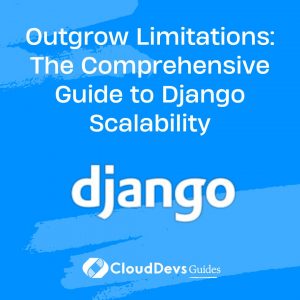Outgrow Limitations: The Comprehensive Guide to Django Scalability
Django, a high-level Python web framework, has steadily been gaining popularity as a robust solution for web development. But as your website or web application grows and attracts more traffic, how does Django hold up? The answer is pretty well, with the right approaches and best practices in place.
Table of Contents
In this post, we will delve deep into how Django can be tailored to handle high traffic websites and apps, complete with real-world examples.
1. Understanding Scalability
Before we get started, it’s vital to understand what scalability means. Scalability refers to the ability of a system to handle an increased load or demand efficiently without compromising performance. It can be vertical (adding more resources, such as RAM or CPU to an existing server) or horizontal (adding more machines or instances to a system).
2. Django’s Built-In Scalability Features
Django comes with a variety of features that support scalability:
- Database Abstraction: The Object-Relational Mapping (ORM) system lets you interact with databases seamlessly. By optimizing database queries using the ORM, you can handle large datasets efficiently.
- Middleware and Caching: Django provides a caching framework that can store parts or the entirety of your website to serve it faster to users. This can drastically improve response times during high traffic.
- Connection Persistence: Connection pooling, especially when using databases like PostgreSQL, helps in efficiently managing database connections, making the system ready for high concurrent users.
3. Real-World Examples: Scaling Django for High Traffic
Example 1: Instagram
Instagram, one of the most popular social media platforms, initially started as a Django project. With millions of users uploading photos, liking, and commenting, scalability was a challenge. How did they tackle it?
- Sharding: To distribute their data load, Instagram used sharding. Each shard contains a subset of the data and operates independently of others. This prevents one shard’s failure from affecting the entire system and spreads out the load.
- Database Optimization: They tailored their PostgreSQL setup, using connection pooling and fine-tuning to reduce the number of database hits.
- Caching: Instagram employed Memcached to cache user data and reduce the load on their databases.
Example 2: Disqus
Disqus, the global comment system platform, also utilizes Django. Handling millions of comments every day, scalability is at its core.
- Database Denormalization: Instead of sticking strictly to normalized database design principles, Disqus denormalized certain tables to reduce the number of joins and make queries faster.
- Partitioning: Disqus partitions its databases based on the type of data they hold. For instance, active comments and historical comments are stored separately.
- Caching: Just like Instagram, Disqus also uses Memcached extensively.
4. Strategies to Scale Your Django Application
- Use a Content Delivery Network (CDN)
A CDN can cache and deliver content to users from the nearest geographical location. This not only reduces the load on your main server but also provides faster content delivery to users worldwide. Django’s static and media files can be served using CDNs like Cloudflare or Amazon CloudFront.
- Optimize Database Queries
The Django Debug Toolbar can be used to identify slow queries. Using `select_related` and `prefetch_related` can help reduce the number of database hits.
- Use Dedicated Cache Systems
While Django’s in-built caching is good, using dedicated caching systems like Redis or Memcached can take it to the next level.
- Load Balancing
For horizontal scaling, use a load balancer like Nginx or HAProxy to distribute incoming requests among multiple server instances.
- Stateless Design
Ensure your application is stateless so any instance can handle any request. This way, if one instance fails, others can take over, ensuring high availability.
- Monitoring and Logging
Using tools like Sentry for error tracking and Grafana or Prometheus for monitoring helps in identifying bottlenecks early.
Conclusion
Django, with its rich set of features and a thriving community, is fully capable of powering high traffic websites and applications. The key lies in understanding its capabilities and implementing best practices tailored for scalability. Whether you’re building the next social media giant or an eCommerce store, with the right strategies in place, Django can be your partner in ensuring smooth sailing, even during the highest tides of traffic.
Table of Contents







